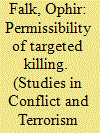| Srl | Item |
| 1 |
ID:
091487


|
|
|
|
|
| Publication |
2009.
|
| Summary/Abstract |
This article examines the ways and means in which states employ irregular and indigenous personnel in a counter-insurgency (COIN) or counter-terrorist (CT) campaign, in the historical and contemporary context. The authors clarify the terminology surrounding this neglected area of COIN/CT theory, and identify four types of indigenous assistance - individual actors (trackers, interpreters, informers and agents); home guards and militias; counter-gangs; and pseudo-gangs. This article concludes that while the use of such indigenous irregulars has its advantages for the state and its armed/security forces (particularly as far as intelligence, local knowledge and undermining the insurgent's cause is concerned), it can also have serious practical and ethical implications for a COIN/CT campaign, and can have unexpected and unwelcome consequences including violations of laws of armed conflict, the undermining of governmental authority and the prospects of endemic internal strife and state collapse.
|
|
|
|
|
|
|
|
|
|
|
|
|
|
|
|
| 2 |
ID:
142310


|
|
|
|
|
| Summary/Abstract |
Military systems exploiting new technologies must meet the requirements of International Humanitarian Law (IHL), but advanced processing and networks raise problems for legal reviews. Tony Gillespie examines the engineering solutions to these challenges, especially the problems of increased system complexity and increased autonomy. He concludes that full compliance with IHL can be achieved as part of a properly planned procurement process, even for radically new technologies. This requires cross-disciplinary collaboration from the earliest concept and design stages.
|
|
|
|
|
|
|
|
|
|
|
|
|
|
|
|
| 3 |
ID:
132175


|
|
|
|
|
| Publication |
2014.
|
| Summary/Abstract |
Targeted killing has become an increasingly prevalent tactic employed by states in their efforts to counter terrorism. Despite its widespread use, the criteria for targeted killing permissibility have remained vague. This article identifies and evaluates the circumstances under which targeted killings can be considered permissible and looks at on-the-ground implementation by Israel and the United States. While both Israel and the United States may have largely adhered to the laws of armed conflict, in practice, discrepancies in implementation exist. This is primarily due to the ambiguity of the "distinction" and "proportionality" principles, two key legal and moral criteria that need further clarification.
|
|
|
|
|
|
|
|
|
|
|
|
|
|
|
|